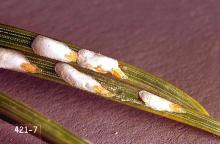Includes
Black pineleaf scale (Dynaspidiotus [formerly Nuculaspis] californica)
Juniper scale (Carulaspis juniperi)
Pine needle scale (Chionaspis pinifoliae)
Pest description and damage Scale insects are small (less than 0.125 inch in length) soft insects that live beneath waxy scales. These insects are often identified by the shape and size of their scales, the description of adult males and females, immature crawler stage, color of eggs, and host plant preferences. The needle scale insects are about 0.125 inch in diameter, elongate, under white scale. Each scale has a cast larval skin at the narrow end. Males are smaller and more elongate. Red eggs are laid beneath the female scale. The newly hatched crawlers are yellow and flat. The more mature nymphs and adults feed on the needles. Heavily infested trees may appear crusty white or "flocked." Infested needles turn yellow, then brown. Twigs and branches may be killed. Repeated infestations eventually may kill plants. Pine needle scales are often found with the black pineleaf scales, which are convex scales, about 0.06 inch in length, black with gray margins and a central yellow area. Pine needle scales are most serious on ornamental pines that are under stress or along dusty roads. This insect may infest arborvitae, cedar, hemlock, spruce, and Douglas-fir. The female juniper scales are about 0.06 inch in diameter, shaped like a small round volcano with a yellow top (cast off crawler "skin"), while the males are elongate with the cast skin at the narrow end. Crawlers are bright yellow but fade to tan as they begin to form the scale cover.
Biology and life history The pine needle scale overwinters as red eggs under cover of the female scale. Eggs hatch in spring and reddish crawlers move along needles and molt, becoming yellow with a dark central spot. A second generation occurs in mid-summer (July). Black pineleaf scale eggs are laid in June and hatch into crawlers in July and spend winter feeding on foliage. There is one generation per year in Oregon. The juniper scale overwinters as eggs beneath the female scale. Eggs hatch in spring and the pale-yellow crawlers move to the last season's needles. Once females settle, they will remain in that spot.
For biology, life history, monitoring and management
See "Scale insect" in:
Management-chemical control
See Table 1 in:
Chemical Control of Landscape Pests
For more information
Anon. Juniper scale in Pests of Trees and Shrubs. IPM of Midwest Landscapes, p. 159. University of Minnesota. p.159 (https://pesticidecert.cfans.umn.edu/sites/pesticidecert.cfans.umn.edu/files/2022-06/159JuniperScale.pdf)



